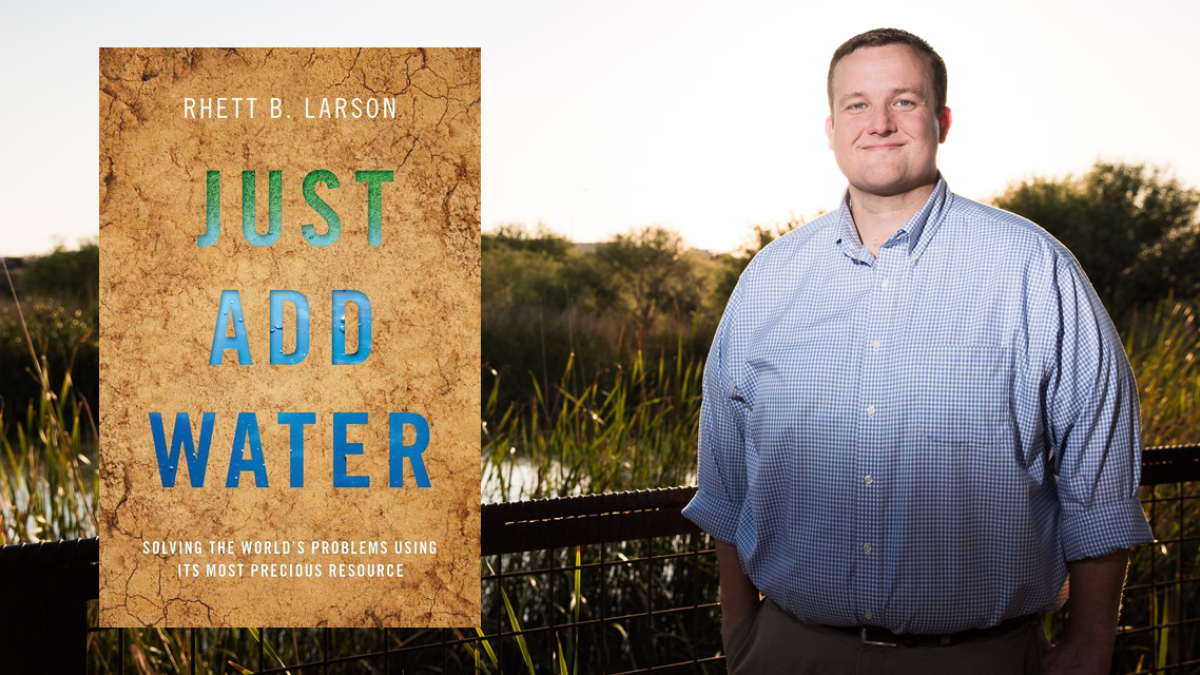ASU Law professor outlines critical role of water in world’s biggest issues

In his new book, Rhett Larson, the Richard Morrison Professor of Water Law at the Sandra Day O’Connor College of Law, explains how water is the common element in so many of humankind’s most pressing challenges.
There is no magic wand that can solve all of the world’s problems. But water might be the closest thing.
In his new book, Rhett Larson, the Richard Morrison Professor of Water Law at the Sandra Day O’Connor College of Law at Arizona State University, explains how water is the common element in so many of humankind’s most pressing challenges.
Released in April, the book titled “Just Add Water: Solving the World’s Problems Using Its Most Precious Resource” was written in part to correct widespread misconceptions about the scope of water law, something Larson has been dedicated to his entire professional life.
“People will ask me what sort of law I teach, and I’ll say water law,” he said. “And they’ll often say, ‘Oh, well that’s very narrow.’ And I’ll just think, ‘Narrow? How can water law be narrow?’ Most of the world — and most of us — is water. What area of law could have broader importance and a broader impact than water law? So in some ways the book is about showing people just how central water is to virtually every problem on Earth.”
To illustrate the point, Larson addresses social challenges chapter by chapter in his book, underscoring water’s impact on a wide range of issues. For some, such as climate change, the connection to water is readily apparent. But perhaps less so for issues such as racism, gender inequality, terrorism, war, mass migrations and space travel.
“Water is at the center of all of those problems,” Larson said. “So if we were to pick any problem on Earth to invest our time and energy into fixing, looking for the most impact in as many areas of our lives as possible, if we would just focus on water security — helping every person have enough clean water at acceptable costs and risks — that would go further in solving more problems than any other intervention we could have.”
Pandemic underscores water’s impact
Larson finished writing the book in September, several months before the first whispers of coronavirus began. But the book includes a prescient chapter on the pivotal connection between water and outbreaks of infectious disease.
Now, several months later, with the world in the throes of the COVID-19 pandemic, epidemiologists have been thrust into the public spotlight.
“And the beginning of modern epidemiology really began with a water question,” Larson said.
He explains the origins can be traced to John Snow, a 19th-century English physician (not the “Game of Thrones” character).
“In London in the 19th century, they were seeing repeated outbreaks of cholera, and a lot of the prevailing scientific theory at the time was that the cholera was spreading by miasma, contaminated air,” Larson said. “So the government would crack down on industries that they thought were polluting the air and making people sick. People would light large bonfires all over London to burn and clean the air.”
But Snow, Larson said, was able to isolate a critical variable involving water. He noticed that people who were living upstream of sewer discharges in the Thames River were largely safe, but people who lived downstream were the ones who were, predominantly, getting sick.
“In particular, there were large clusters of sick people around a well that was on Broad Street in London, and that was located near a septic system,” Larson said. “So his theory was that it must be coming from the sewage, it must be coming from water pollution. And legend has it that John Snow went to this pump on Broad Street and broke the handle off of it to keep people from drinking contaminated water and saved the city.”
More than a century later, Larson says, another London-based epidemiologist, David Bradley, further highlighted the intimate relationship between infectious disease and water. In 1972, Bradley and his colleagues unveiled the Bradley Classification, which places disease transmission into four categories, all directly linked to water:
- Water-borne diseases, such as cholera and typhoid, which are transmitted through contaminated water sources.
- Water-washed diseases, such as diarrhea, which occur when a lack of clean water compromises personal hygiene.
- Water-based diseases, involving hosts that live in the water. Examples include schistosomiasis, a thin worm hosted by snails, and dracunculiasis, commonly known as guinea worm.
- Water-related insect vectors, transmitted by insects that breed in water. Most notably malaria and dengue fever.
All of these infectious diseases are directly related to water availability and water security, Larson said, and he points out in his book that water policy is often siloed in what he calls the blue and the green agenda.
“Most water experts either focus on the blue agenda, which is water rights and getting people enough water supply, or the green agenda, which involves water quality and keeping people from polluting the water,” he said. “But I am arguing that people should also focus on what's called the red agenda. The red agenda is focusing on disease vectors.”
Larson points to the Diama Dam, built in the 1980s on the Senegal River in Africa. Although it addressed the blue agenda by improving water access, such projects can bring mosquito-breeding environments closer to humans, or expand snail habitat for more schistosomiasis transmission. A similar tradeoff is made right here in Arizona, as expanded water infrastructure heightens the risk of the mosquito-borne West Nile virus.
“And what happens when we say, ‘Well, we want to address mosquito breeding by putting pesticides in the water to kill mosquito larvae,’ but there are laws or regulations that prevent that discharge? That's focusing on the green agenda, protecting water quality and avoiding pollution,” Larson said. “But it might aggravate the red agenda, allowing more mosquitoes to breed. So the chapter is really about helping us find ways to reconcile the blue and the green agenda with the red agenda — making water law more sensitive to public health.”
Exploring solutions
The issues involving water and public health are complex and require due diligence and a delicate balancing act. Larson suggests allowing for emergency permitting procedures, which could result in greater water pollution, at least in the short term, in order to expedite actions intended to combat disease. He also recommends a public health analysis for any water infrastructure projects. Just as any large public works project is preceded by an environmental impact assessment, the ultimate impact on public health should be studied in advance of constructing canals or dams.
Larson also stresses the importance of integrating local stakeholders into decision-making processes on water policy. To point out how priorities might differ by location, he talks about disinfection byproducts, or DBPs, which are created when disinfectants such as chlorine are used to address organic pollution. DBPs like total trihalomethanes or bromides are carcinogenic, so they are closely regulated in the United States.
“But what if you have a small village in a developing community and you build a drinking-water treatment system?” Larson asks. “If there's a lot of organic pollution in that river and you treat it with chlorine, there's going to be disinfectant byproducts. But the reality is that in that community, they don't have the luxury of worrying about getting cancer in 60 years — they're worried about getting cholera tomorrow. So when we develop systems, we need to think about what the water quality standards should be in order to meet the concerns of that particular system. And if we have to trade off concerns — acute concerns for pathogens versus chronic concerns for carcinogens — sometimes that's a trade-off you have to make. And the only way to make it is by integrating local feedback and local stakeholder participation.”
Closer to home, Larson points to the current plight of the Navajo Nation – which spans portions of Arizona, New Mexico and Utah. Despite a largely rural landscape with low population density, the Navajo Nation has the highest per capita COVID-19 infection rate in the country, surpassing even New York City. It seems an anomaly for such a sparsely populated region to be so hard-hit by a disease spread by close human contact. But once again, Larson says, water is a critically important factor.
“They have small communities that are spread out very far, and it's difficult to provide a sustainable, affordable, adequate water supply,” he said. “So it's hard for people to be able to get enough water for the kind of hygiene that’s needed to fight this disease. And hygiene, washing our hands, is the most important thing that we can do.”
Larson points out the luxury that many Americans may take for granted, having nearly unlimited access to clean water from multiple points in our homes and businesses.
“One of the best ways that we can help our neighbors and our family in the Navajo Nation, and to make sure that this never happens again, is to find a way to get more resources to them, to be able to improve their water infrastructure and improve water security,” he said.
More Law, journalism and politics

Opportunities and risks of AI in the court system
“Science and innovation have always been an important part of ASU Law,” said Stacy Leeds, dean of Arizona State University’s…

Law and addiction: How new science is impacting the justice system
For years, people who struggle with drug addiction have often been considered weak or in need of incarceration by the general…

Exhibit uses rare memorabilia to illustrate evolution of US presidential campaigns
After one of the most contentious elections in history, a new museum exhibit offers a historical perspective on the centuries-old…